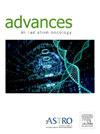Investigating the Uptake of Hypofractionation for Breast and Prostate Cancer in Sub-Saharan Africa: A Qualitative Study of Physician and Medical Physicist Perspectives
IF 2.7
Q3 ONCOLOGY
引用次数: 0
Abstract
Purpose
In prostate and breast cancer, moderate hypofractionation (HF) has demonstrated comparable, if not greater, efficacy than conventional fractionation. There is a stark disparity in the uptake of HF between North America and Africa. Using the Consolidative Framework for Implementation Research, we evaluated barriers and facilitators for implementing HF in Sub-Saharan Africa (SSA).
Methods and Materials
Radiation oncologists and medical physicists working in SSA were recruited via the AORTIC Radiation Oncology Special Interest Group and subsequent snowball sampling. Interviews were conducted virtually between November 2022 and January 2023. Transcripts were analyzed using directed content analysis guided by a Consolidative Framework for Implementation of research interview domains and constructs.
Results
In total, 19 interviewees (17 radiation oncologists and 2 medical physicists) from 11 SSA countries participated, of which 94% noted the use of HF (40.05 Gy/15fx or 42.67 Gy/16fx) in breast cancer clinics and 38% in prostate cancer clinics (60-66 Gy/20fx). While nearly all participants identified the benefits of HF for both clinics and patients, many also noted that the lack of long-term data within an African population created discomfort in using HF. Many participants believed in the utility of HF but expressed a lack of confidence in its use caused by uncertainty about the safety of the technique, especially in centers with cobalt or 3-dimensional conformal radiation therapy-only capabilities. In breast HF, participants expressed concern regarding breast size and ideal eligibility criteria for patients. In prostate HF, on-treatment imaging and lack of fiducials were identified as barriers. Key facilitators in adopting HF included hands-on training, partnerships with disease-site-specific individuals with HF experience, and consensus on patient eligibility and technique requirements.
Conclusions
HF is regarded as a valuable tool for breast and prostate cancer in SSA, and breast HF is widely used. Attention to the use of 3-dimensional conformal radiation therapy with HF, long-term toxicity data in African populations, and training sessions may facilitate further use of HF for prostate cancer.
在撒哈拉以南非洲调查乳腺癌和前列腺癌的低分割吸收:医生和医学物理学家观点的定性研究。
目的:在前列腺癌和乳腺癌中,中度低分割术(HF)的疗效与常规分割术相当,如果不是更强的话。在北美和非洲之间,HF的吸收存在明显的差异。利用实施研究综合框架,我们评估了在撒哈拉以南非洲(SSA)实施HF的障碍和促进因素。方法和材料:通过主动脉放射肿瘤学特别兴趣小组和随后的滚雪球抽样招募在SSA工作的放射肿瘤学家和医学物理学家。采访在2022年11月至2023年1月期间进行。在研究访谈领域和结构的实施整合框架的指导下,使用定向内容分析来分析成绩单。结果:共有来自11个SSA国家的19名受访者(17名放射肿瘤学家和2名医学物理学家)参与,其中94%的人注意到乳腺癌诊所使用HF (40.05 Gy/15fx或42.67 Gy/16fx), 38%的人注意到前列腺癌诊所使用HF (60-66 Gy/20fx)。虽然几乎所有的参与者都认为心衰对诊所和患者都有好处,但许多人也指出,缺乏非洲人群的长期数据,这导致了使用心衰的不适。许多参与者相信高频辐射的效用,但由于该技术的安全性不确定,特别是在仅具有钴或三维适形放射治疗能力的中心,他们对使用高频辐射缺乏信心。在乳房HF中,参与者表达了对乳房大小和患者理想资格标准的关注。在前列腺HF中,治疗期间的影像学检查和缺乏基线被认为是障碍。采用心衰的关键促进因素包括实践培训、与具有心衰经验的特定疾病部位的个人合作以及对患者资格和技术要求的共识。结论:在SSA中,HF被认为是诊断乳腺癌和前列腺癌的一种有价值的工具,乳腺HF应用广泛。关注HF的三维适形放射治疗的使用,非洲人群的长期毒性数据,以及培训课程可能有助于进一步使用HF治疗前列腺癌。
本文章由计算机程序翻译,如有差异,请以英文原文为准。
求助全文
约1分钟内获得全文
求助全文
来源期刊

Advances in Radiation Oncology
Medicine-Radiology, Nuclear Medicine and Imaging
CiteScore
4.60
自引率
4.30%
发文量
208
审稿时长
98 days
期刊介绍:
The purpose of Advances is to provide information for clinicians who use radiation therapy by publishing: Clinical trial reports and reanalyses. Basic science original reports. Manuscripts examining health services research, comparative and cost effectiveness research, and systematic reviews. Case reports documenting unusual problems and solutions. High quality multi and single institutional series, as well as other novel retrospective hypothesis generating series. Timely critical reviews on important topics in radiation oncology, such as side effects. Articles reporting the natural history of disease and patterns of failure, particularly as they relate to treatment volume delineation. Articles on safety and quality in radiation therapy. Essays on clinical experience. Articles on practice transformation in radiation oncology, in particular: Aspects of health policy that may impact the future practice of radiation oncology. How information technology, such as data analytics and systems innovations, will change radiation oncology practice. Articles on imaging as they relate to radiation therapy treatment.
 求助内容:
求助内容: 应助结果提醒方式:
应助结果提醒方式:


